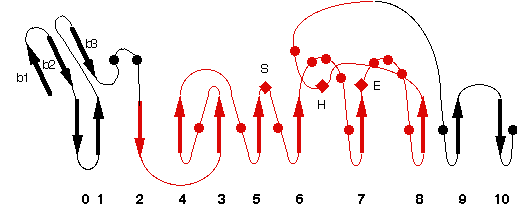2WIG
Name : Non aged form of human butyrylcholinesterase inhibited by tabun analogue TA4
Revelation date : 19-May-2009
Family : BCHE
Gene_locus : human-BCHE
PDB file : ESTHER: header of PDB entry RCSB: Full entry
Comment
Carletti, E., Aurbek, N., Gillon, E., Loiodice, M., Nicolet, Y., Fontecilla, J., Masson, P., Thiermann, H., Nachon, F., Worek, F.
Ligand :
References (1)
| Title : Structure-activity analysis of aging and reactivation of human butyrylcholinesterase inhibited by analogues of tabun. - Carletti_2009_Biochem.J_421_97 |
| Author(s) : Carletti E , Aurbek N , Gillon E , Loiodice M , Nicolet Y , Fontecilla-Camps JC , Masson P , Thiermann H , Nachon F , Worek F |
| Ref : Biochemical Journal , 421 :97 , 2009 |
| Abstract : Carletti_2009_Biochem.J_421_97 |
| ESTHER : Carletti_2009_Biochem.J_421_97 |
| PubMedSearch : Carletti_2009_Biochem.J_421_97 |
| PubMedID: 19368529 |
| Gene_locus related to this paper: human-BCHE |
Representative scheme of Prolylcarboxypeptidase structure and an image from PDBsum server

